2 Mar 2021
Summer allergies – getting ready for arrival of seasonal ills in equids
Imogen Johns discusses conditions that can cause significant welfare issues in affected horses, with a look at clinical signs, treatment and prevention.

Figure 1. Patchy alopecia and areas of self-trauma in a horse with allergic skin disease.
The advent of summer brings a smile to the face of most horse owners. No more riding (and poo picking) in the dark, no more slogging through the quagmire of a field to find the rugs in one corner and the horse in another, and no more frozen fingers breaking the ice on the water buckets.
However, for some owners the longer days and warmer weather bring a whole new set of challenges. Summer allergies, in particular insect bite hypersensitivity (IBH; “sweet itch”) and summer pasture-associated severe equine asthma (SPA-SEA), can significantly impact the health and welfare of affected horses during these warmer months.
Helping owners prepare for the allergy season so clinical disease is minimised is key; a thorough knowledge of disease pathogenesis, diagnosis, treatment and, most importantly, prevention will help veterinary surgeons effectively manage these often frustrating cases.
IBH
IBH is a type-1 (immediate and late phase) and type-4 (delayed) hypersensitivity to antigens (presumably salivary) from numerous Culicoides midge species and possibly other insects. Its prevalence varies between countries, breeds and geographical locations, and in the UK it is estimated IBH affects approximately 3% to 10% of horses (Littlewood, 1998).
Clinical signs occur in warmer weather, when midges are most active. Intense pruritus – in particular along the ventral abdomen, mane and tail – results in initial wheals and papules, which rapidly develop into excoriations, exudation of serum and patchy alopecia due to self-inflicted skin trauma (Figure 1). With chronicity, the “classic” signs of hairless, profoundly thickened skin with transverse ridges are seen.
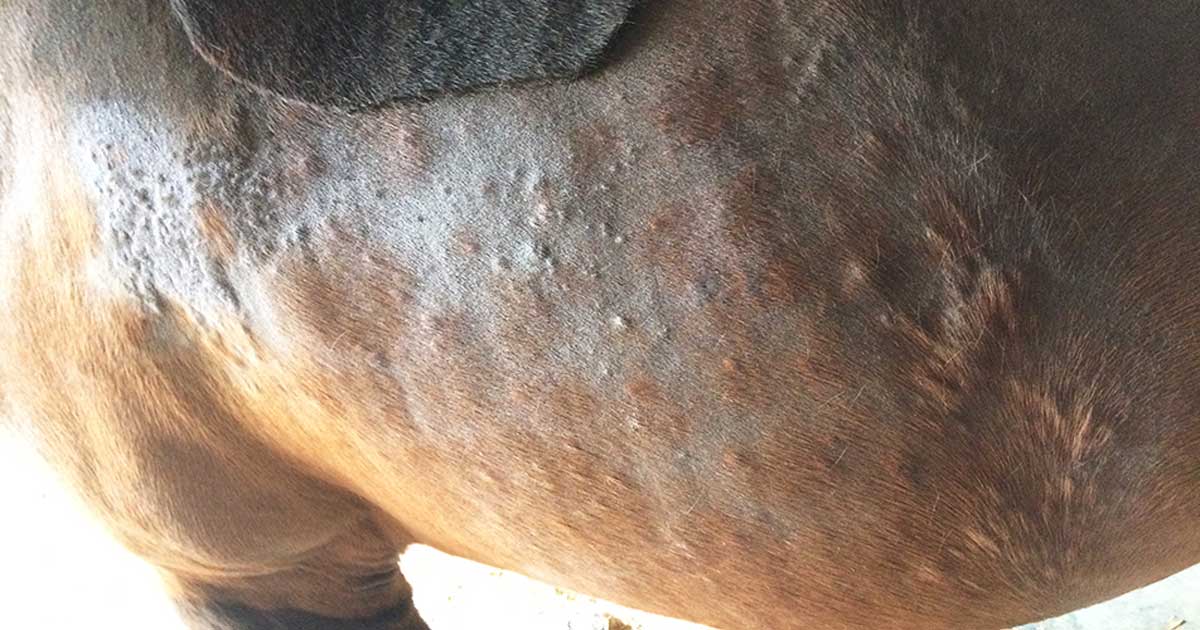
No definitive tests for the diagnosis of IBH are available. Diagnosis relies on the presence of classic clinical signs, seasonality and the exclusion of other causes of pruritus – in particular ectoparasites (Figure 2).
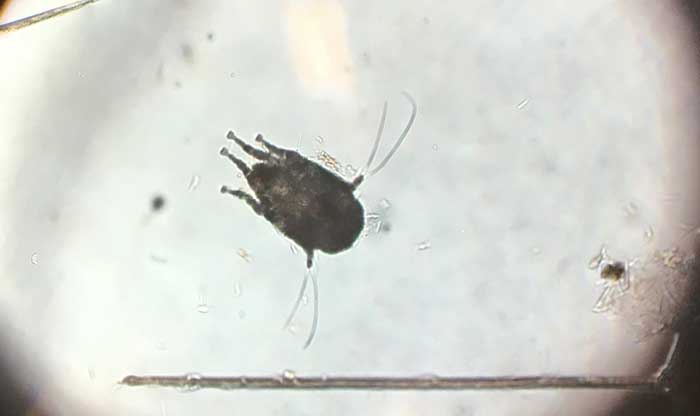
Because the disorder is a true hypersensitivity, large numbers of midges do not need to be obvious in the horse’s environment, and companion horses sharing the same pasture and management can be unaffected. Although serum IgE level measurement and intradermal skin testing (IDST) using Culicoides allergens can be performed, the tests tend to have low sensitivity and/or specificity – possibly because the allergens used may not be those the horse is exposed to, as multiple species of midges tend to have geographical predilections.
In a study in the Netherlands, utilisation of an indigenous Culicoides species for IDST in IBH horses showed a high sensitivity and specificity for detecting differences between affected and control horses, suggesting IDST may be useful for diagnosis (and, therefore, possibly for allergen-specific immunotherapy; ASIT) if appropriate allergens are used (Sloet van Oldruitenborgh-Oosterbaan et al, 2009; Figure 3).
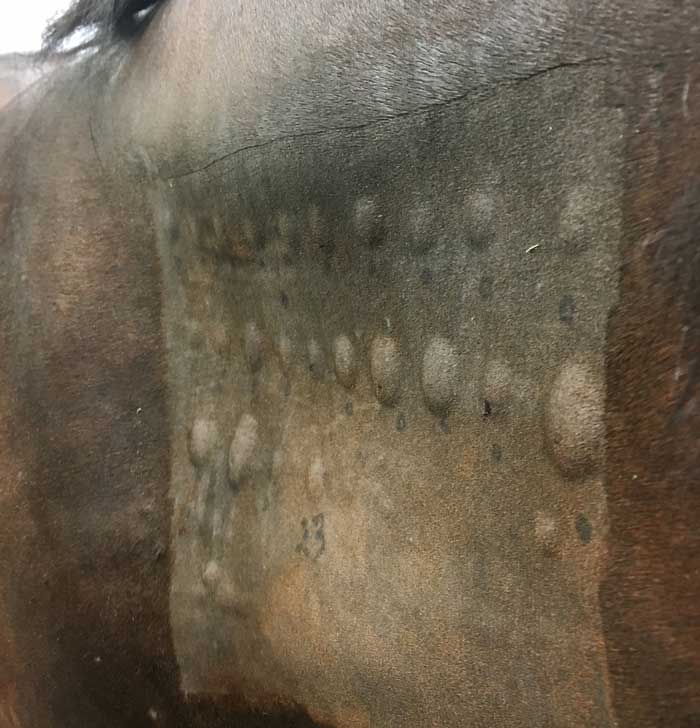
Management of affected horses involves controlling pruritus, skin care (including treatment of secondary infections if required) and, most importantly, preventive strategies (so the horse and the midge will never meet).
Controlling pruritus
Corticosteroids are the mainstay of controlling clinical signs in severely affected horses. Although they can be very effective, their long-term use is not recommended, and every effort should be made to minimise the need for “rescue” therapy.
Systemic or topical steroids can both be effective, and the choice between the two will likely depend on the size and location of the area requiring treatment, the severity of signs and the perceived risk of side effects – in particular laminitis.
No topical steroid products are licensed for use in horses, but numerous canine and human products are available as sprays and ointments/lotions, which can be useful (Figure 4).
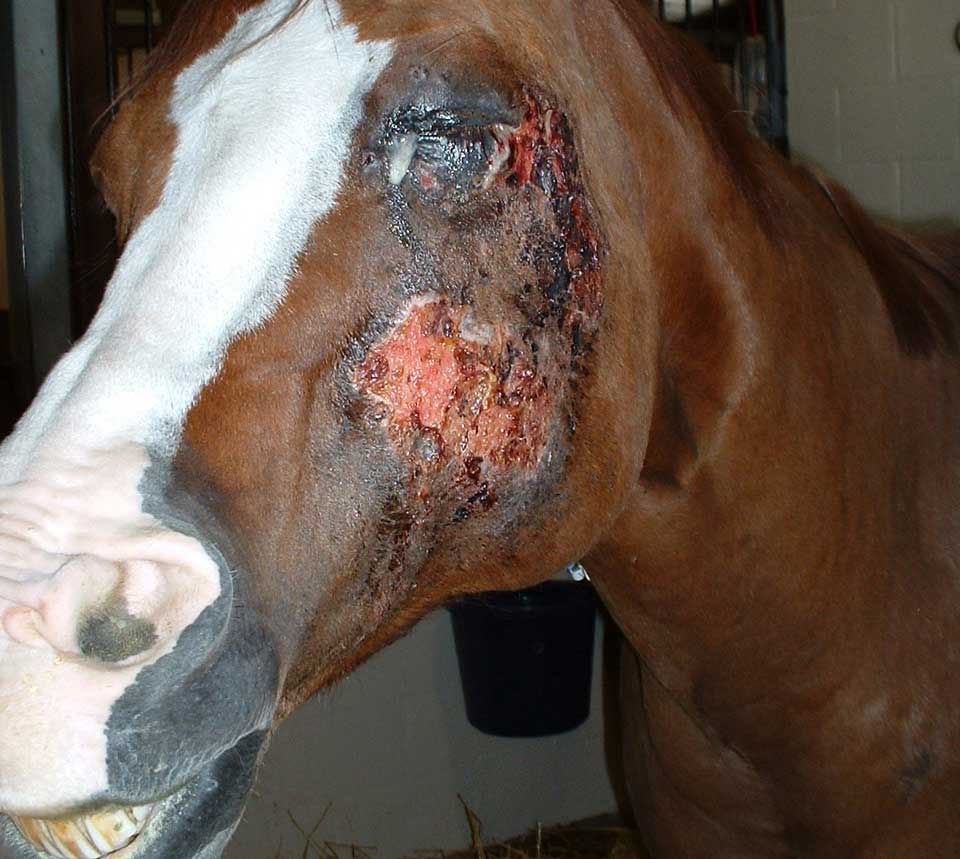
If systemic steroids are utilised, dexamethasone (0.01mg/kg to 0.1mg/kg by mouth/IV/IM once a day to every other day) or prednisolone (1mg/kg once a day by mouth) are both appropriate choices and should be used until the pruritus is controlled before the dose is decreased.
Antihistamines do not seem to be particularly effective in horses with IBH-related pruritus, although, anecdotally, treatment prior to the development of signs has been reported to be helpful in some horses.
Skin care
The intensity of the pruritus can result in significant skin damage secondary to self-trauma in severely affected horses. Controlling the pruritus to prevent further skin damage is an essential first step. In cases with suspected bacterial pyoderma, medicated shampoos can be both soothing and assist in resolving the infection.
Examples of shampoos include those containing chlorhexidine, benzoyl peroxide and ethyl lactate. It is important to follow a manufacturer’s instructions for use for each product, as appropriate contact time is often important to maximise efficacy. Colloidal oatmeal shampoos can be useful long term, as they have antipruritic properties, and can moisturise and clean the coat.
Prevent horse/midge contact
Anyone who has managed a horse with chronic, poorly controlled IBH will know that prevention (that is, stopping the midges from biting the horse) is key in minimising the impact on the welfare of impacted horses. Unfortunately, it is often very difficult to achieve, but every effort should be made to minimise the chances that sensitised horses can be bitten.
Midges are most active at dawn and dusk, and horses, therefore, should be stabled during these times, as midge numbers will be lower indoors. When stabled, use of very fine mesh screens is useful to prevent insect entry into the stable itself. Fans can also be used to blow the midges (which are relatively weak flyers) away from the horse. Midges breed in and around standing water, and can only fly approximately half a mile from these sites, so, when turned out, affected horses should be housed as far as possible away from these areas.
High hedges and woodland also provide shelter for midges so should be avoided. The ideal pasture for a horse with IBH is on top of a windy hill, far from woodland, hedges and standing water – something that, of course, is not often available. As such, additional preventive measures to minimise the chances of horses being bitten are necessary.
Rugs that cover as much as possible of the horse (including the ventral abdomen; Figure 5) and insect repellents are utilised and can be very effective, but do require diligence on the part of owners. Insect repellents should contain at least 2% permethrin (the higher the concentration, the more likely the product will repel insects rather than just kill them on contact), and will typically need to be applied several times a day to both horse and rugs.
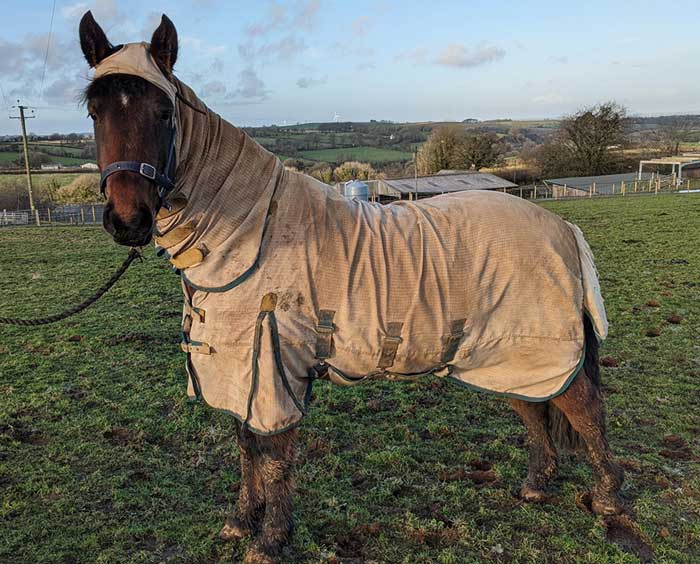
Other treatments
Many “natural” products claim efficacy as antipruritic agents, skin soothers and insect repellents, but most have little to no data to support their efficacy. However, a study utilising an essential oils product has shown some promise (Cox et al, 2020).
A double-blinded placebo-controlled clinical trial utilising a product containing peppermint, lemongrass, may chang, camphor and patchouli applied to horses with IBH showed that those treated had a significant reduction in their clinical signs compared to both before treatment and to untreated controlled, with 17 out of 20 horses having their signs resolve with treatment.
This small study suggests use of this or similar products in horses with IBH may be beneficial.
Modulation of the immune response to allergens may be useful in horses with IBH. Although ASIT has not been shown to be beneficial, this may be more because inappropriate allergens (that is, a non-indigenous Culicoides allergen) was utilised, although further studies will be required to confirm this. In atopic horses with concurrent IBH, ASIT may be beneficial to help lower the so called “allergy threshold” rather than to directly modify the immune response to Culicoides.
Other vaccine candidates have been trialled, with those targeted against interleukin (IL) 5 and IL-31 shown to improve clinical signs in limited studies. The use of Insol Dermatophyton (the “ringworm vaccine”) prior to the insect-biting season has been anecdotally reported to be effective in some horses with IBH, although studies to support its efficacy are currently lacking.
Other products, such as nicotinamide (vitamin B3) and omega-3 fatty acids, are similarly lacking in published studies to demonstrate their efficacy, but may be useful in some horses.
SPA-SEA
Pasture asthma is a disorder characterised by recurrent episodes of bronchoconstriction and neutrophilic airway inflammation. Classically, horses are described as having signs similar to SEA, but occurring when at pasture in the warmer months, with respiratory distress, expiratory wheezes on auscultation, a cough and exercise intolerance reported.
In all other aspects except for the season of occurrence, it is virtually indistinguishable from SEA in stabled horses. Indeed, in a small proportion of affected horses, year-round signs are seen, whether the horse is kept at pasture or in a stable.
The disorder is characterised by airway hyperreactivity to inhaled allergens, although the specific allergens remain unknown. Pollens and mould spores are commonly implicated, and in the UK at least, signs are often exacerbated during periods of hot, dry weather or after harvesting local crops (Mair, 1996; Costa et al, 2006; McGorum and Dixon, 1999).
Management of horses with pasture asthma can be very challenging, as stabling with low-dust bedding and forage results in improvement in only a small proportion of cases. As such, corticosteroids (either systemic or inhaled), as well as bronchodilators, are often required to control episodes and may also be required longer term to prevent recurrence during risk periods. As information is limited regarding efficacious treatments in these horses, and because the disease is very similar to SEA, drugs, doses and durations are typically extrapolated from these protocols (Johns, 2020).
| Corticosteroids and bronchodilators used in the treatment of summer pasture-associated severe equine asthma | |||
|---|---|---|---|
| Drug* | Dose | Route of administration | Frequency |
| Dexamethasone sodium phosphate | 0.01mg/kg to 0.164mg/kg** | IV/IM/by mouth | Once a day |
| Prednisolone | 1mg/kg to 2mg/kg | By mouth | Once a day |
| Beclomethasone dipropionate | 1µg/kg to 5µg/kg (2-10 actuations) | Inhaled | Twice a day |
| Fluticasone propionate | 2µg/kg to 4µg/kg (4-8 actuations) |
Inhaled | Twice a day |
| Clenbuterol | 0.8µg/kg to 3.2µg/kg | IV/by mouth | Twice a day |
| Salbutamol | 2µg/kg (10 actuations) | Inhaled | Every 2-4 hours |
| Salmeterol | 0.5µg/kg (10 actuations) | Inhaled | Twice a day |
| Budesonide | 3.5µg/kg (8 actuations) | Inhaled | Twice a day |
| Ciclesonide | Day 1-5: 8 actuations Day 6-10: 12 actuations |
Inhaled | Twice a day Once a day |
| Salmeterol and fluticasone | 0.2µg/kg to 0.4µg/kg 2-4µg/kg (4-8 actuations) |
Inhaled | Twice a day |
| *All inhaled medications apart from ciclesonide are used via the cascade and, therefore, informed consent should be sought. **Higher doses for by mouth use. |
|||
Summary
Horses with summer allergies can be difficult to manage, but, with planning, many can be effectively prevented from developing the most severe clinical signs.
Early treatment and ongoing management are vital to help provide effective and ongoing relief.
- Use of some treatments mentioned in this article would be under the cascade.
References
- Costa LR et al (2006). Temporal clinical exacerbation of summer pasture-associated recurrent airway obstruction and relationship with climate and aeroallergens in horses, Am J Vet Res 67(9): 1,635-1,642.
- Cox A et al (2020). Essential oil spray reduces clinical signs of insect bite hypersensitivity in horses, Aust Vet J 98(4): 411-416.
- Johns IC (2020). Equine asthma – a broad look at problems, causes and treatment, VT Equine 6(1): 17-19.
- Littlewood J (1998). Incidence of recurrent seasonal pruritus (‘sweet itch’) in British and German shire horses, Vet Rec 142(3): 6-67.
- Mair T (1996). Obstructive pulmonary disease in 18 horses at pasture, Vet Rec 138(4): 89-91.
- McGorum BC and Dixon PM (1999). Summer pasture associated obstructive pulmonary disease (SPAOD): an update, Equine Vet Educ 11(3): 121-123.
- Sloet van Oldruitenborgh-Oosterbaan MM et al (2009). Intradermal testing of horses with and without insect bite hypersensitivity in the Netherlands using an extract of native Culicoides species, Vet Derm 20(5-6): 607-614.
